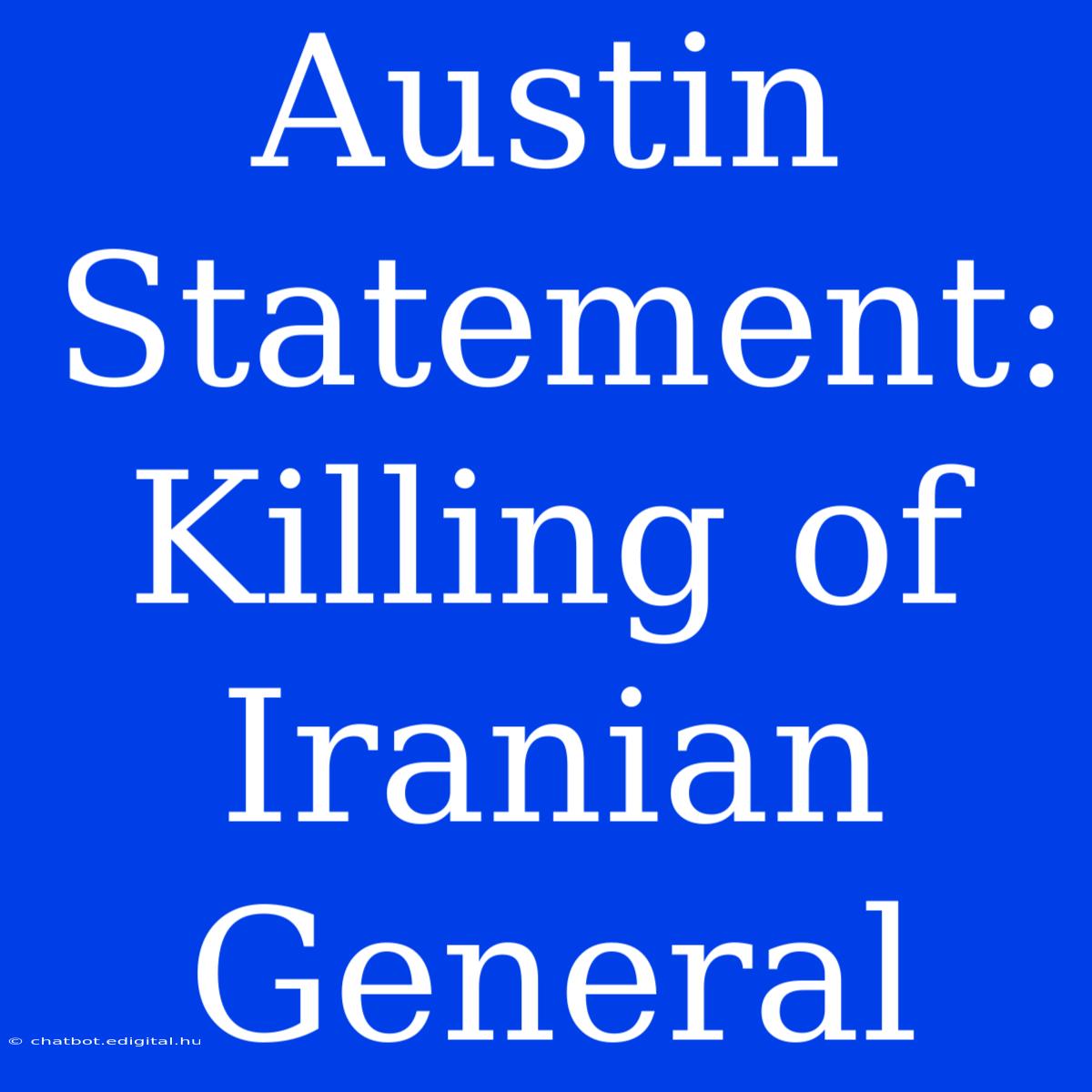The Austin Statement: A Turning Point in the US-Iran Relationship?
The Austin Statement: A Turning Point in the US-Iran Relationship? The assassination of Iranian General Qasem Soleimani by the United States in 2020 sparked international outrage and raised concerns about escalating tensions between the two nations. This event, also known as the "Austin Statement," is a crucial moment in the ongoing US-Iran conflict, demanding a thorough analysis of its implications.
Editor Note: This article explores the complexities of the Austin Statement and its lasting impact on the delicate balance between the United States and Iran. Understanding this event is critical for navigating the future of international relations and global security.
Why is this topic important? The Austin Statement marked a significant escalation in tensions between the US and Iran. It led to a range of responses, including Iranian retaliatory attacks and heightened regional instability. Understanding the statement's nuances is crucial for grasping the broader context of the US-Iran relationship and its impact on global affairs.
Analysis: This analysis delves into the Austin Statement's background, the rationale behind the assassination, and its immediate and long-term consequences. We'll explore the statement's impact on the US-Iran relationship, its role in shaping regional dynamics, and the potential for future escalation.
Key Takeaways of the Austin Statement:
| Aspect | Details |
|---|---|
| Background | Soleimani's role as head of Iran's Quds Force and alleged involvement in attacks against US interests. |
| Rationale | US claims of imminent threat from Soleimani and his forces, aimed at deterring future Iranian aggression. |
| Consequences | Iranian retaliation, heightened regional tensions, and a potential escalation of the conflict. |
| International Reactions | Condemnation from various countries, including allies of the US, and concerns over the escalation of violence. |
| Long-Term Implications | A deepening of mistrust and a potential for further instability in the region. |
The Austin Statement:
- Context: The statement emerged from a complex geopolitical backdrop marked by tensions between the US and Iran over the Iranian nuclear program, US sanctions, and regional proxy conflicts.
- Rationale: The US administration argued the assassination was necessary to prevent future attacks by Soleimani and his forces. Critics argued it was a provocative act that could lead to broader conflict.
- Consequences: The assassination sparked immediate retaliation from Iran, including a missile attack on US forces in Iraq. It also led to a heightened state of alert and increased military deployments in the region.
- Impact on US-Iran Relations: The statement further strained relations between the two countries, pushing them closer to a direct confrontation.
- Regional Impact: The assassination contributed to increased instability in the Middle East, particularly in Iraq, Syria, and Lebanon.
The Killing of General Soleimani:
- Soleimani's Role: As head of the Quds Force, Soleimani was a powerful figure within Iran's military, responsible for operations outside the country.
- US Perspective: The US government considered Soleimani a significant threat due to his alleged involvement in attacks on US troops and interests in the region.
- Iranian Perspective: Iran viewed Soleimani's killing as an act of aggression and a threat to its national security.
- International Response: The assassination triggered a global response, with many countries expressing concern about the escalation of tensions in the region.
Consequences and Aftermath:
- Iranian Retaliation: Iran responded with a missile attack on US military bases in Iraq.
- Regional Instability: The event increased tensions in the region, with the potential for further conflict and instability.
- US-Iran Relationship: The assassination further deepened mistrust between the US and Iran, making it difficult to find common ground.
- Global Implications: The event highlighted the dangers of escalating tensions between major powers and the potential for unforeseen consequences.
Summary: The Austin Statement represents a turning point in the US-Iran relationship. It serves as a reminder of the fragility of peace in the region and the need for diplomacy and de-escalation. The assassination has long-term implications for the US-Iran relationship, regional stability, and global security.
Closing Message: This event underscores the need for careful and calculated policy decisions regarding the US-Iran relationship. The path towards a more stable future requires dialogue, understanding, and a commitment to peaceful resolution of disputes.
FAQs
Q: What was the purpose of the Austin Statement? A: The US government cited a need to prevent future attacks by Soleimani and his forces as the primary rationale for the assassination.
Q: How did Iran react to the killing? **A: ** Iran retaliated with a missile attack on US military bases in Iraq.
Q: What were the international reactions to the assassination? A: Many countries, including allies of the US, condemned the killing and expressed concern over the escalation of tensions in the region.
Q: What are the long-term implications of the Austin Statement? A: The statement has deepened mistrust between the US and Iran, making it more difficult to find common ground and potentially leading to further instability in the region.
Q: What steps can be taken to de-escalate tensions between the US and Iran? A: Diplomacy, open communication, and a willingness to address underlying issues are essential for de-escalating tensions.
Tips:
- Stay informed about developments in the US-Iran relationship.
- Engage in respectful dialogue and consider multiple perspectives.
- Support diplomatic efforts to resolve the conflict peacefully.
Summary:
The Austin Statement marked a significant escalation in the US-Iran conflict, with both immediate and long-term consequences. It highlighted the need for carefully crafted policies that avoid further provocations and foster dialogue and understanding between the two nations.
Closing Message: The Austin Statement underscores the importance of diplomacy and restraint in navigating complex geopolitical challenges. The path towards a more peaceful and stable future requires commitment to dialogue and a shared vision for a safer world.

